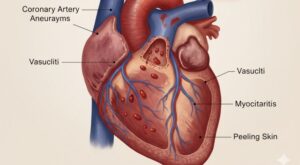Beyond the Mat: The Medical Science Behind Yoga

Celebrating World Yoga Day 2025 with Evidence, Intention, and Inner Balance
Every year on June 21st, the world comes together in breath, balance, and movement to celebrate International Day of Yoga. But this year, let’s take a deeper step—not just onto the mat, but into the science-backed health benefits of yoga that go far beyond flexibility.
At Nellikka.life, we believe that traditional practices like yoga, when combined with modern medicine and lifestyle awareness, can bring revolutionary improvements in well-being. Let’s explore how yoga stands strong in the realm of medicine, backed by scientific journals, clinical studies, and mind-body research.
1. The Medical Definition of Yoga
Yoga is no longer just a cultural or spiritual ritual—it is a recognized complementary medical practice. When structured for therapeutic purposes, yoga blends:
- Asanas (physical postures)
- Pranayama (breath regulation)
- Dhyana (meditation)
Clinical studies across PubMed, The Lancet, and PLOS One confirm that these elements collectively regulate physiological, neurological, and hormonal responses—restoring body-homeostasis and mental equilibrium.
2. Yoga & Heart Health
Did you know yoga can be cardioprotective?
- Reduces blood pressure and heart rate
- Improves lipid profiles and endothelial function
- Reduces inflammatory markers like CRP and IL-6
A 2022 meta-analysis in PLOS One confirmed significant cardiovascular improvements in individuals with hypertension and pre-diabetic symptoms after just 8 weeks of yoga practice.
3. Mental Health & Neuroplasticity
Yoga is a prescription for the mind as much as the body.
- Reduces cortisol (stress hormone)
- Increases serotonin and GABA (mood regulators)
- Enhances brain areas involved in focus, memory, and calmness
According to The Lancet Psychiatry, yoga therapy is comparable to antidepressants in mild-to-moderate depression, without the side effects.
4. Strength, Posture & Pain Relief
Yoga is gentle but powerful.
- Improves balance in elderly patients
- Eases back pain and arthritis (recognized by NIH and AIIMS)
- Enhances muscle tone, joint stability, and spinal alignment
The British Journal of Sports Medicine recognizes yoga as effective as physiotherapy in managing chronic lower back pain.
5. Immunity & Inflammation
What happens when stress lowers your immunity? Yoga rises.
- Yoga reduces pro-inflammatory cytokines (CRP, IL-6, TNF-α)
- Boosts immune resilience by calming the HPA-axis
- Helps chronic illnesses like PCOS, diabetes, and even cancer recovery
Yoga acts like an immuno-modulator, helping your body respond better to disease
6. Sleep, Hormones & Energy
Regular yoga practitioners report:
- Deeper sleep
- Fewer mood swings
- Higher energy
- Better hormonal balance (especially in women)
According to Cleveland Clinic and PubMed data, yoga increases melatonin and improves parasympathetic tone (rest and digest mode).
Vagus Nerve Stimulation & The Science Behind Yoga
In recent years, the connection between yoga and vagus nerve stimulation has become a hot topic in both neuroscience and holistic wellness. But what exactly is the vagus nerve, and how does yoga benefit it?
What is the Vagus Nerve?
The vagus nerve—sometimes called the “wandering nerve”—is the longest cranial nerve in the body, connecting the brain to vital organs like the heart, lungs, digestive tract, and more. It plays a key role in the parasympathetic nervous system, which governs our body’s rest, relaxation, and digestion.
When the vagus nerve is activated or “stimulated,” it slows the heart rate, lowers blood pressure, and reduces inflammation, all of which are essential for physical and emotional well-being.
How Yoga Naturally Stimulates the Vagus Nerve
Scientific studies have shown that yoga postures (asanas), breathing practices (pranayama), and meditation can directly influence vagal tone—which refers to the activity level of the vagus nerve. The better your vagal tone, the more resilient and calm your body and mind are in response to stress.
Key yoga practices that stimulate the vagus nerve:
Inversions (like Viparita Karani): Help redirect blood flow and engage the vagus pathway.
Slow, deep breathing (Pranayama): Activates parasympathetic pathways.
Chanting ‘Om’ or humming: Causes vibrations in the vocal cords, stimulating vagal afferents.
Meditation and mindfulness: Promote vagal activation through mental relaxation.
Science Backs It Up
A 2018 study published in Frontiers in Human Neuroscience revealed that mind-body practices like yoga can enhance vagal tone, improving emotional regulation and reducing symptoms of depression and anxiety.
The Journal of Clinical Psychology found that yoga practitioners had lower cortisol levels, attributed to improved vagal function.
Vagus nerve stimulation (VNS) is used clinically to treat epilepsy, depression, and even inflammatory disorders—but yoga offers a non-invasive, cost-free alternative to achieve similar benefits.
Benefits of Vagal Activation Through Yoga
✔️ Improved focus and sleep
✔️ Reduced anxiety and stress
✔️ Better heart rate variability (HRV)
✔️ Improved digestion and gut-brain connection
✔️ Enhanced emotional regulation
✔️ Better immune response
Practical Takeaway for World Yoga Day 2025
This Yoga Day, don’t just practice—understand why yoga works.
Whether you’re:
- A busy professional with back pain
- A student with anxiety
- A mother seeking balance
- Or a senior battling sleep or stiffness
…yoga has a customized, research-proven solution for you.
How to Begin
Start with 15 minutes a day
Combine simple poses with mindful breathing
Use props if needed—yoga is adaptable
Keep a routine—it’s the consistency that heals
Facts
- Over 300+ PubMed-indexed studies on yoga therapy
- Recognized by WHO and AYUSH for holistic health
- Practiced in 190+ countries as part of integrative medicine
Yoga is not just fitness—it’s preventive care, mental detox, and emotional clarity rolled into one. On this World Yoga Day, take your first breath into a lifelong practice that transforms not only your body, but your brain, your breath, and your being.
Scientific References :
1. PLOS One: Yoga for Cardiovascular Risk Factors
2.The Lancet Psychiatry: Yoga & Depression
3. Yoga and immune system functioning: a systematic review of randomized controlled trials




